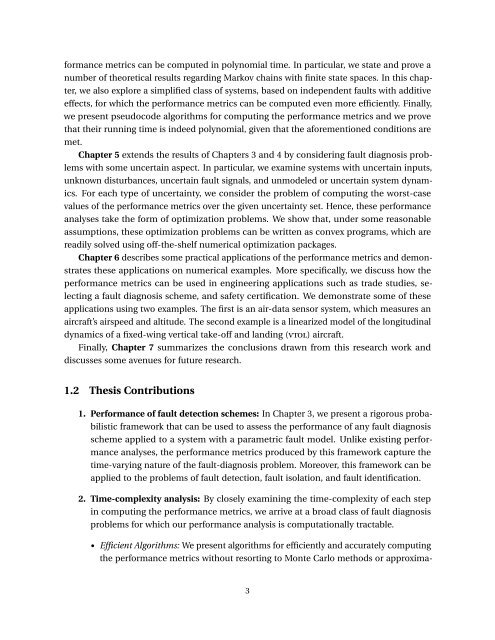Probabilistic Performance Analysis of Fault Diagnosis Schemes
Probabilistic Performance Analysis of Fault Diagnosis Schemes
Probabilistic Performance Analysis of Fault Diagnosis Schemes
You also want an ePaper? Increase the reach of your titles
YUMPU automatically turns print PDFs into web optimized ePapers that Google loves.
formance metrics can be computed in polynomial time. In particular, we state and prove a<br />
number <strong>of</strong> theoretical results regarding Markov chains with finite state spaces. In this chapter,<br />
we also explore a simplified class <strong>of</strong> systems, based on independent faults with additive<br />
effects, for which the performance metrics can be computed even more efficiently. Finally,<br />
we present pseudocode algorithms for computing the performance metrics and we prove<br />
that their running time is indeed polynomial, given that the aforementioned conditions are<br />
met.<br />
Chapter 5 extends the results <strong>of</strong> Chapters 3 and 4 by considering fault diagnosis problems<br />
with some uncertain aspect. In particular, we examine systems with uncertain inputs,<br />
unknown disturbances, uncertain fault signals, and unmodeled or uncertain system dynamics.<br />
For each type <strong>of</strong> uncertainty, we consider the problem <strong>of</strong> computing the worst-case<br />
values <strong>of</strong> the performance metrics over the given uncertainty set. Hence, these performance<br />
analyses take the form <strong>of</strong> optimization problems. We show that, under some reasonable<br />
assumptions, these optimization problems can be written as convex programs, which are<br />
readily solved using <strong>of</strong>f-the-shelf numerical optimization packages.<br />
Chapter 6 describes some practical applications <strong>of</strong> the performance metrics and demonstrates<br />
these applications on numerical examples. More specifically, we discuss how the<br />
performance metrics can be used in engineering applications such as trade studies, selecting<br />
a fault diagnosis scheme, and safety certification. We demonstrate some <strong>of</strong> these<br />
applications using two examples. The first is an air-data sensor system, which measures an<br />
aircraft’s airspeed and altitude. The second example is a linearized model <strong>of</strong> the longitudinal<br />
dynamics <strong>of</strong> a fixed-wing vertical take-<strong>of</strong>f and landing (vtol) aircraft.<br />
Finally, Chapter 7 summarizes the conclusions drawn from this research work and<br />
discusses some avenues for future research.<br />
1.2 Thesis Contributions<br />
1. <strong>Performance</strong> <strong>of</strong> fault detection schemes: In Chapter 3, we present a rigorous probabilistic<br />
framework that can be used to assess the performance <strong>of</strong> any fault diagnosis<br />
scheme applied to a system with a parametric fault model. Unlike existing performance<br />
analyses, the performance metrics produced by this framework capture the<br />
time-varying nature <strong>of</strong> the fault-diagnosis problem. Moreover, this framework can be<br />
applied to the problems <strong>of</strong> fault detection, fault isolation, and fault identification.<br />
2. Time-complexity analysis: By closely examining the time-complexity <strong>of</strong> each step<br />
in computing the performance metrics, we arrive at a broad class <strong>of</strong> fault diagnosis<br />
problems for which our performance analysis is computationally tractable.<br />
• Efficient Algorithms: We present algorithms for efficiently and accurately computing<br />
the performance metrics without resorting to Monte Carlo methods or approxima-<br />
3













